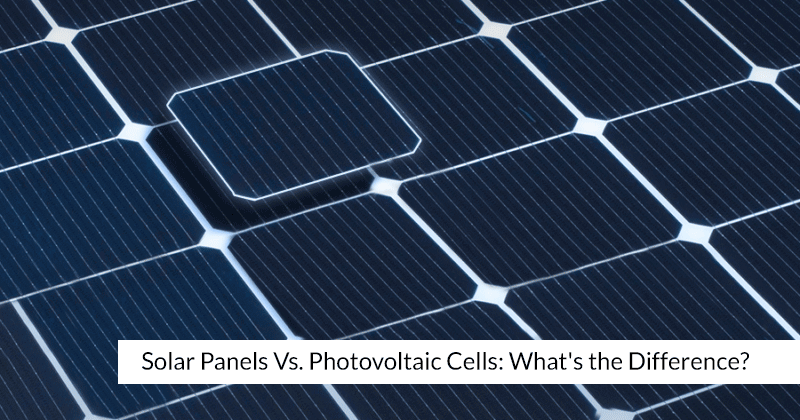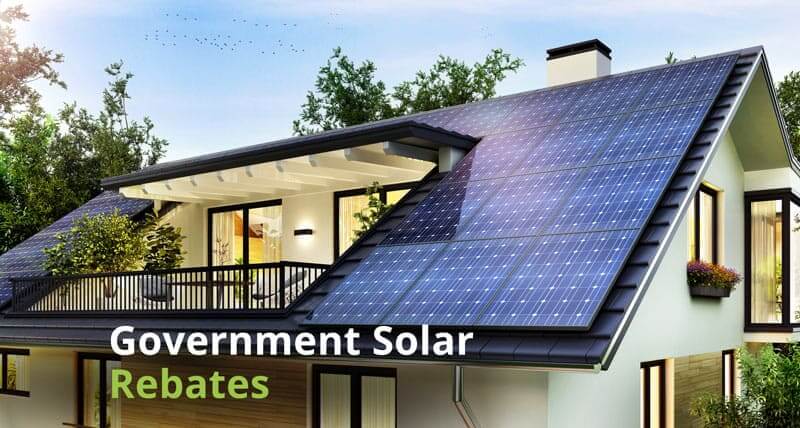Home Difference Between Solar Panels and Photovoltaic Cells
Solar Panels Vs. Photovoltaic Cells: What's the Difference?
Solar panels and photovoltaic cells are often thought to be identical, with many believing there’s no difference between the two. But is this assumption accurate?
Well, technically, no. Solar panels and photovoltaic cells are two distinct parts of your solar photovoltaic system. A photovoltaic cell is a single electronic component containing layers of silicon semiconductors that convert solar energy into electrical energy. A solar panel, on the other hand, is an assembly of multiple photovoltaic cells.
In this article, we will examine at the difference between solar panels and photovoltaic cells and how they work. Read on to learn more.

Table of Contents
ToggleWhat is a photovoltaic cell?
A photovoltaic cell, also commonly known as a solar cell, is a non-mechanical electronic component that generates electricity when exposed to sunlight.
PV cells are made of two layers of silicone that contain semiconductor material. The top semiconductor material contains extra electrons, which gives it a negative charge. On the other hand, the bottom semiconductor has missing electrons, which gives it a positive charge.
How do photovoltaic cells work?
Here is how PV cells convert sunlight to electricity:
- To function, a PV cell needs an electric field. When photons from the sun hit the top semiconductor material, the loose electrons become excited and are knocked out of the semiconductor material’s atoms. The dislodged electrons are then attracted to the positive semiconductor material.
- The movement of the free electrons (each with a negative charge) creates an imbalance of electrical charge between the front and back surfaces of the cell. This imbalance creates an electric current.
- The electrical conductors then transmit the electric current that created into an external electrical load for use in your home.
When electrons re-enter the cell, this process is repeated to ensure you have sufficient electricity to meet your daily needs.
Limitations of Photovoltaic cells
- The consumer cannot directly use an individual photovoltaic cell.
- One PV cell can only generate 1 to 2 watts of electricity, which is only enough to power small devices like wristwatches and calculators. You will, therefore need a complete solar PV system to generate enough power for your home.
What is a solar panel?
A solar panel, also called a solar module, is an assembly of several photovoltaic cells electrically connected in a series of parallel circuits. The solar cells are encapsulated in a protective case against harsh weather and mounted in a metal framework for installation.
How does a solar panel function?
Solar photovoltaic panels vary widely in size and the amount of electricity they can generate. The electricity-generating capacity of a solar panel depends on the number of PV cells and its surface area.
A solar panel amplifies, directs, and protects the electrical current from the PV cells. PV cells usually generate direct-current (DC) electricity.
The direct current (DC) generated by your solar PV panel or array is passed through an inverter system (a central inverter or microinverter), where it is converted into alternating current (AC) that can be used in your home.
How many PV cells are in one solar panel?
The number of photovoltaic cells in your solar panel depends on its size and brand. A solar panel comes in a square or rectangular arrangement of PV cells. Consequently, a single panel can contain 32, 36, 48, 60, 72, or 96 PV cells.
A solar panel containing 32 PV cells can produce about 14.72 volts of electricity, with each cell producing about 0.46 volts. On the other hand, a 72-cell solar PV panel can produce up to 33.12 volts of electricity and their average output is somewhere between 350 and 400 watts
A standard 250-watt polycrystalline solar module comprises 60 PV cells in a rectangular arrangement.
Solar Panels Vs. Photovoltaic Cells: What's the Difference?
Here are the main differences between solar panels and photovoltaic cells.
Difference between solar panels and photovoltaic cells
| Photovoltaic cells | Solar photovoltaic panels |
|---|---|
| Main component that makes up a solar panel | An assembly of solar PV cells that makes up a solar system |
| Converts sunlight into electricity | Amplifies, protects and, directs the electricity |
| Produces a small amount of electricity that can only run small devices | Produces higher currents of energy and when connected to an array, they can power your home |
What is a solar PV system?
A solar system contains two main components:
- Solar photovoltaic cells
- Solar panel
As we have already noted, solar panels and PV cells are fundamental, closely connected parts of your solar photovoltaic system. Photovoltaic cells are the basic building blocks of a solar PV panel, and several solar panels make up a solar PV array.
A solar photovoltaic system can comprise of one or more solar panels. Usually, the number of solar PV panels connected in a PV system determines the amount of electricity the system can generate.
How does a solar PV system function?
A solar PV array converts solar energy into electrical energy through the photovoltaic effect. This electricity can be used at your home or on your commercial premises.
In a photovoltaic panel, the parameters of the electricity generated are adjusted by the inverter component of the PV system. This inverter is responsible for converting the direct current into an alternating current.
Another key characteristic of a photovoltaic system is that it can operate even if the sun is not out.
If a PV system has gathered enough energy during sunny days, some mechanisms and procedures allow using of the generated and gathered electricity even in the fall or winter months.
What is the photovoltaic effect?
The photovoltaic effect is the process through which photovoltaic cells absorb and convert sunlight into electrical energy. The PV effect makes solar panels useful.
What are the different types of solar panels?
In today’s market, three main types of solar panels are available. These are:
- Thin-film solar panels
- Monocrystalline solar panels
- Polycrystalline solar panels
Naturally, each of these types has different characteristics and varied capabilities in terms of performance. Below, you can find their details and other information that you can use to decide which solar panel is best for your needs.
| Type of Solar Panel | Material | Cost per Watt installed | Efficiency |
|---|---|---|---|
| Thin-film solar panel | Amorphous silicon (a-Si) Copper Indium gallium selenide (CIGS) Cadmium telluride (CdTe) Gallium arsenide | $0.70 to $1.10 | 12% to 14% (Medium-efficiency) |
| Monocrystalline Solar Panel | Pure, single silicon crystal | $1.25 to $1.87 | 15% - 23% |
| Polycrystalline Solar Panel | Silicon fragments | $1.13 to $1.00 | 11% or may reach 15% (Low-efficiency) |
Thin-film solar panels
Thin-film solar panels are different from monocrystalline and polycrystalline solar panels since they are much newer in the solar industry and only sometimes designed from silicon.
Considered part of the 2nd generation of solar panels, this type is used in PV power stations, small-scale solar systems, or is integrated into buildings.
Thin-film solar panels are the least expensive of the three types, making them the best choice for those on a strict budget.
Thin-film solar panels typically cost $0.70 to $0.90 per watt, translating from $231 to $297 per 330 watts.
Monocrystalline solar panels
Monocrystalline solar panels are considered the most efficient and developed variant in the solar market, which explains why they have been on the market for quite some time.
This type is highly durable, making it the top choice for homeowners and property owners when they want to be assured of a durable and efficient solar system.
Monocrystalline panels are also considered part of the 1st generation and are commonly used in conventional applications as they have the highest power output. This also makes them the most expensive.
Popular among homeowners because of their visual appeal, monocrystalline solar panels have a uniform black colour because of their pure silicone composition.
This type costs approximately $1.00 to $1.25 per watt, or $330 to $495 per 330 watts.
Polycrystalline solar panels
Also called “multi-crystalline solar panels,” polycrystalline solar panels are a newer type and are becoming popular because they are highly efficient despite being low-cost.
Their low cost is because of their design and their faster manufacturing process.
Although considered 1st generation, they are less efficient than monocrystalline solar panels.
Poly solar panels typically have a blue hue due to the silicon fragments and do not have cut corners. Because of this, they can be less efficient since the electrons do not have plenty of room to roam around because of their structure and composition.
Comparing mono and poly solar panels does not reveal significant differences.
Polycrystalline solar panels can cost you between $0.90 and $1.00 per watt. This can be translated into $297 to $330 per 330 watts.
Note: The estimated and average costs above can vary depending on your preference, budget, location, and your preferred power output.
Advantages of solar panels
Solar has been used for commercial, government, or even residential purposes for many decades. Their functions are for the long-term, and their benefits are apparent for their purposes, which might explain their popularity.
However, while they may already be popular, there might still be many advantages and disadvantages that you need to learn.
Below are some of the main advantages of solar panels:
- Generates clean, green, and renewable energy
- They help reduce electric bills.
- Solar panels are cost-efficient, and if eligible, you can get government incentives for installing solar panels.
- Solar panels easily convert solar power into electricity for home or commercial use.
- They can supply power in areas without electricity distribution systems or power lines.
- PV systems can also supply power to the electricity grid.
- Solar panels have diverse applications, including photovoltaics and solar thermal.
- Solar panels have low maintenance costs because they don’t require frequent maintenance.
How much do photovoltaic panels cost?
The average cost of solar panels in Australia is $7,410 for the common 6.6 kWh solar system. This price is inclusive of the government’s solar rebate. The cost will vary widely depending on location (STC zone), your desired solar system size and brand, and solar provider.
Table of Contents
Toggle




